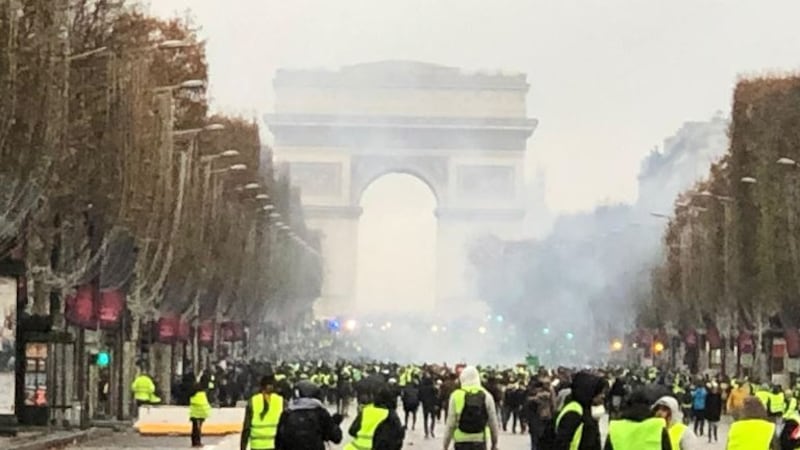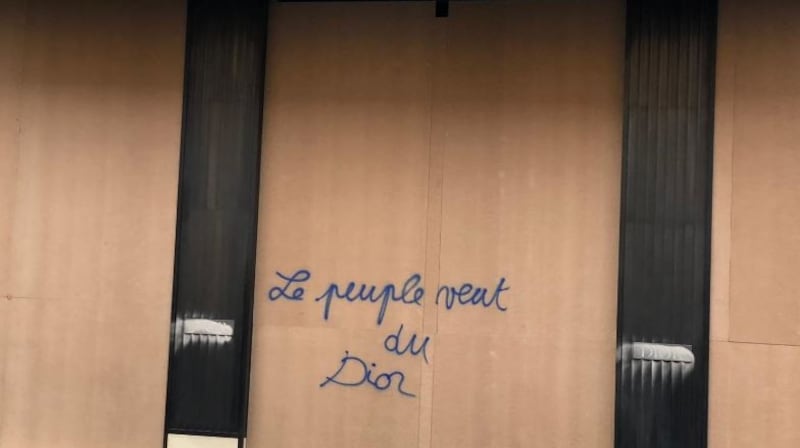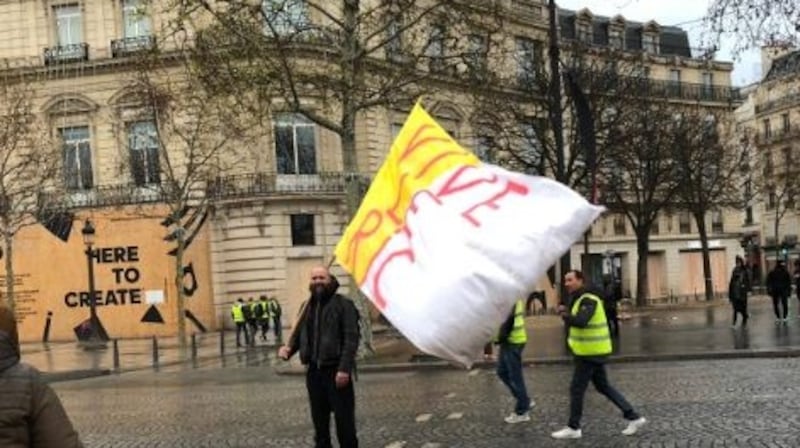Several police vehicles were parked on the corner below my apartment building. Cops checked identity papers of pedestrians in my neighbourhood, where numerous government ministries are located. The place du Palais Bourbon, seat of the National Assembly, was enclosed in a giant cage.
I encountered three gilets jaunes wearing hi-visibility security vests in the rue Saint Dominique. They had fled the Champs-Élysées, at most a mile away, choking with tear gas. The three friends, Erwan, Joelle and Cédric, had taken a train at Provins, in the Aube department of eastern France, at 5.30am to join the Paris demonstration. They are typical of the unstructured protest movement.
When the friends arrived at the Gare de l’Est they were stopped at a police checkpoint just outside the station and their ski goggles, which they had brought to protect themselves from tear gas, were confiscated. The metro was closed so they walked 45 minutes to reach the Champs-Élysées.
It was peaceful “until around 10.15, when they started firing tear gas”, said Joelle (31), a stay-at-home mother of two. “It burns. It makes you cry. Your eyes close on their own and you can’t see anything at all for a few seconds,” said Erwan. “Watch which way the wind is blowing,” Joelle advised me, since I was heading towards the demonstration. “Run in the opposite direction of the wind, because the wind brings the tear gas towards you. I earn the Smic (minimum wage) of €1,200 per month,” said Erwan.
The condition of his teeth reminded me that former president François Hollande allegedly called the poor les sans dents. As we talked on the pavement, cars drove by hooting their horns, to show solidarity with the yellow vests. Though support for the movement has faltered somewhat since riots broke out on the last two Saturdays, polls still show that more than 70 per cent of the population agree with their demands for lower taxes and higher living standards. All the cars hooted except a Porsche, I noted.
"We're going to stick them with the wealth tax again!" said Erwan. President Emmanuel Macron cancelled the wealth tax on capital, but not property, last year. Its re-establishment is a new demand by the yellow vests, since Macron annulled a hated rise on carbon tax on fuel. The three friends from eastern France demonstrated in their own department the first two weeks, then decided to come to Paris.
“We have to show our strength. We have to show that the countryside is coming to Paris,” said Erwan. As far as he was concerned, the struggle was only “for purchasing power and for less taxes”. A worker in a door and window factory, he pays no income tax. But between “rent, electricity, insurance, petrol and filling the fridge”, his salary runs out by the third week of the month.
President Macron is the target of protesters “because he’s the one in power. Because he gives presents to the rich and because he doesn’t want to answer to us,” said Erwan.
“Why aren’t there any rich people in the demonstrations?” asked Joelle. There was an element of class warfare to the protests, she admitted. “The rich people look down on us.” But Erwan interjected: “We don’t hate rich people. It’s the injustice we hate, the difference between rich and poor.”
Cédric (28) had just completed a six-month contract in a tyre factory, where he earned €1,500 per month. “We’re waiting to see what comes next,” he said. “We want higher salaries, lower-priced petrol and for them to tax rich people. They’ve just raised the salaries for the CRS (riot police), so they can raise everybody else’s.”
If Macron would resign, said Erwan, “that would be Utopia”. The three friends said the violence that marked the last two marches, on December 1st and 8th, was unfortunate but necessary. “I came to demonstrate, not to fight,” said Joelle. “But there has to be breakage. Otherwise no one pays attention.”



Many of the skirmishes between police and rioters took place in side streets off the Champs-Élysées. It was strange to see police and yellow vests mingling in calm parts of the city, then suddenly confronting each other in riot zones. A few dozen yellow vests rested around a dry fountain on the place Francois 1er, near the Champs-Élysée. I struck up a conversation with an agitated young man holding ski goggles who did not want to give his name or profession.
He kept glancing at the gendarmes advancing into the intersection a few dozen metres away. The young man’s main demand was an RIC – a referendum on citizen’s initiative. A few minutes later, I would see a protester in the middle of the Champs-Élysée brandishing a banner with the initials RIC. He spewed hatred against Macron who, he said “venerates Rothschild (bank) more than his own father”.
The men resting on the edge of the fountain joined in. “If you steal three apples you go to prison. Castaner (the interior minister) should be in prison,” said one. “It’s illegal for me to beat my wife or spank my children,” said another. “But the police strike us with truncheons. They fire grenades at old age pensionsers.”
“I hope you’re not a corrupt media like the French,” said the first young man. “They claim we are only a few tens of thousands. We are millions.”
The gendarmes in the intersection formed a compact circle, with their shields in front of them. Black smoke from a burning car billowed from a side street. A helicopter clattered overhead. A police motorcade with flashing blue lights inched towards the Rond Point des Champs-Élysées, protected by the gendarmes. We followed the police vans down the avenue Montaigne, beneath white Christmas fairy lights.
“The people want Dior,” stated graffiti scrawled on plywood covering the haute couture boutique’s windows. To my right at the roundabout, dozens of gendarmerie and police vans were lined up, as if ready to charge up the avenue des Champs-Élysée. They were in fact protecting the approaches to the Élysée Palace. The yellow vests were grouped to the left, perhaps 100m up the avenue, staring down the security forces opposite.
A line of blue lights at the top of the avenue, in front of the Arc de Triomphe, marked the other frontline, with the yellow vests wedged between. Police repeatedly fired what the yellow vests called “noise bombs”.
There were other detonations and a cloud of tear gas hovered above the protesters. “The noise bombs make as many decibels as a 747 taking off,” said Benoit (31) a management consultant who had returned home from London to take part in the protests. “They can make you permanently deaf.”
Benoit also accused the media of lying. “Look at the yellow vests!” he exclaimed. “There are at least 50,000 of them. We are gaining ground against the fascist forces. We’re holding a third of the Champs-Élysées now . . . The gendarmes are military. They are part of the army. Their role is to protect the people, not the corrupt government . . . This is the biggest military deployment in France since May ’68 . . . We’re fed this line about being the country of human rights. Why don’t they give us some human rights?”
Benoit pulled his ski mask on before jogging back towards the yellow vests. “I have to go join my friends now,” he said. “My rucksack is full of bandages.”










